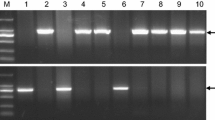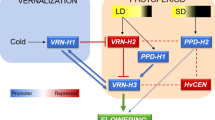Abstract
A two gene epistatic model in which a dominant “winter growth habit” allele at Vrn-H2 encodes a repressor with a corresponding binding site in a recessive vrn-H1 allele explains the vernalization response phenotypes in an array of barley germplasm. In order to validate the model genetically, we developed an F 2 population (and F 2-derived F 3 families) from the cross of Hardy (winter) × Jubilant (spring). Using gene-specific primers, we determined the Vrn-H1 and Vrn-H2 allele architecture of each F 2 plant and we measured the growth habit phenotype of each F 2 plant via phenotyping of its F 3 progeny under controlled environment conditions. We used a set of treatments involving plus/minus vernalization under long photoperiod and vernalization under short photoperiod. Alleles at the two loci showed expected patterns of segregation and independent assortment. Under long day conditions, the two Vrn genes were the primary determinants of heading date, regardless of the vernalization treatment. Under short photoperiod, the effects of these loci were not significant. There was incomplete dominance at Vrn-H1: heterozygotes were significantly later to head than Vrn-H1Vrn-H1 genotypes. Vrn-H2 genotypes were also significantly later to head, even when plants were vernalized. These results validate the two-gene epistatic model for vernalization response under long-day conditions. The results under short photoperiod, and the variance in flowering with vernalization, confirm that while the two Vrn genes are the primary determinants of vernalization response, they are part of a larger interactome that determines the timing of the vegetative to reproductive transition.
Similar content being viewed by others
References
Cooper LLD, von Zitzewitz J, Skinner JS, Szűcs P, Karsai I, Francia E, Stanca AM, Pecchioni N, Laurie DA, Chen THH, Hayes PM (2006) The genetic basis of vernalization responses in barley. In: Chen THH, Uemura M, Fujikawa S (eds) Cold hardiness in plants: molecular genetics, cell biology and physiology. CAB International, Oxon, UK, pp 64–75
Danyluk J, Kane ND, Breton G, Limin AE, Fowler DB, Sarhan F (2003) TaVRT-1, a putative transcription factor associated with vegetative to reproductive transition in cereals. Plant Physiol 132:1849–1860
Decousset L, Griffiths S, Dunford RP, Pratchett N, Laurie DA (2000) Development of STS markers closely linked to the Ppd-H1 photoperiod response gene of barley (Hordeum vulgare L.). Theor Appl Genet 101:1202–1206
Dubcovsky J, Chen C, Yan L (2005) Molecular characterization of the allelic variation at the VRN-H2 vernalization locus in barley. Mol Breed 15:395–407
Dweikat I, Ohm H, Mackenzie S, Patterson F, Cambron S, Ratcliffe R (1994) Association of a DNA marker with Hessian fly resistance gene H9 in wheat. Theor Appl Genet 89:964–968
Fu D, Szűcs P, Yan L, Helguera M, Skinner JS, von Zitzewitz J, Hayes PM, Dubcovsky J (2005) Large deletions within the first intron in VRN-1 are associated with spring growth habit in barley and wheat. Mol Genet Genom 273:54–65
Iwaki K, Haruna S, Niwa T, Kato K (2001) Adaptation and ecological differentation in wheat with special reference to geographical variation of growth habit and Vrn genotype. Plant Breeding 120:107–114
Karsai I, Mé szá ros K, Lá ng L, Hayes PM, Bedő Z (2001) Multivariate analysis of traits determining adaptation in cultivated barley. Plant Breeding 120:217–222
Karsai I, Szűcs P, Mé szá ros K, Filichkina T, Hayes PM, Skinner JS, Lá ng L, Bedő Z (2005) The Vrn-H2 locus is a major determinant of flowering time in a facultative × winter growth habit barley (Hordeum vulgare L.) mapping population. Theor Appl Genet 110:1458–1466
Kato K, Miro Y, Beiles A, Nevo E (1997) Geographical variation in heading date traits in wild emmer wheat, Triticum dicoccoides. I. Variation in vernalization response and ecological differentiation. Theor Appl Genet 95:546–552
Kato H, Taketa S, Ban T, Iriki N, Murai K (2001) The influence of a spring habit gene, Vrn-D1, on heading time in wheat. Plant Breeding 120:115–120
Loukoianov A, Yan L, Blechl A, Sanchez A, Dubcovsky J (2005) Regulation of VRN-1 vernalization genes in normal and transgenic polyploid wheat. Plant Physiol 138:2364–2373
Pan A, Hayes PM, Chen F, Chen THH, Blake T, Wright S, Karsai I, Bedő Z (1994) Genetic analysis of the components of winterhardiness in barley (Hordeum vulgare L.). Theor Appl Genet 89:900–910
Takahashi R, Yasuda S (1971) Genetics of earliness and growth habit in barley. In: Nilan RA (ed) Barley genetics II. Washington State University Press, pp 388–408
Tottman DR, Makepeace RJ (1979) An explanation of the decimal code for the growth stages of cereals, with illustrations. Ann Appl Biol 93:221–234
Turner A, Beales J, Faure S, Dunford RP, Laurie DA (2005) The pseudo-response regulator Ppd-H1 provides adaptation to photoperiod in barley. Science 310:1031–1034
Yan L, Loukoianov A, Tranquilli G, Helguera M, Fahima T, Dubcovsky J (2003) Positional cloning of the wheat vernalization gene VRN1. PNAS 100:6263–6268
Yan L, Loukoianov A, Blechl A, Tranquilli G, Ramakrishna W, SanMiguel P, Bennetzen JL, Echenique V, Dubcovsky J (2004) The wheat VRN2 gene is a flowering repressor down-regulated by vernalization. Science 303:1640–1644
Yasuda S, Hayashi J, Moriya I (1993) Genetic constitution for spring growth habit and some other characters in barley cultivars in the Mediterranean coastal regions. Euphytica 70:77–83
von Zitzewitz J, Szűcs P, Dubcovsky J, Yan L, Francia E, Pecchioni N, Casas A, Chen THH, Hayes PM, Skinner JS (2005) Molecular and structural characterization of barley vernalization genes. Plant Mol Biol 59:449–467
Author information
Authors and Affiliations
Corresponding author
Rights and permissions
About this article
Cite this article
Kóti, K., Karsai, I., Szűcs, P. et al. Validation of the two-gene epistatic model for vernalization response in a winter × spring barley cross. Euphytica 152, 17–24 (2006). https://doi.org/10.1007/s10681-006-9170-z
Received:
Accepted:
Published:
Issue Date:
DOI: https://doi.org/10.1007/s10681-006-9170-z




